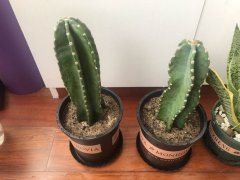How can succulents turn red, the important thing is low temperature
SucculentThe reason why plants are charming is their cute color, but most of the timeSucculentThe colors of plants are all green, how can so much flesh become red? The conventional method is temperature difference, which is why it is in the late autumn seasonSucculentsThe color will become particularly beautiful.
Actually, succulents are the same as other plants. In extreme environments, due to self-preservation, color changes will occur. For example, in summer, when the light is strong, many succulents go to sleep. At this time, we will control water for the purposeIt is to prevent rotten roots. In the case of water shortage and drought, the leaves of succulents will change. This change is very beautiful from an ornamental point of view, but in fact, the plant protects itself.
Similarly, in autumn, because the weather is getting colder and colder, it is naturally felt for succulents. Let’s take a look at what a flower friend said.
The real significant effect on the coloring of succulents is the low temperature, not the temperature difference. In the case of similar low temperatures, areas with large temperature differences will definitely have better colors because invisibility includes better light quality, and light is also a factor that affects the coloring of succulents.Important factor, and for the same area, it can almost be said that in the case of open breeding, which month has the lowest temperature, it is almost the best color in that month unless it is cloudy and rainy, the light is super slow..
The effect of temperature difference and low temperature on the coloring of succulents is indirect and direct. Now everyone basically knows that the coloring of succulents mainly depends on anthocyanins. The content of anthocyanins is related to the metabolism of carbohydrates.Conducive to the accumulation of carbohydrates sugar, because the low temperature in autumn and winter nights reduces the rate of dark respiration and accelerates the accumulation of sugar, thereby promoting the synthesis of anthocyanins. The large temperature difference is so indirectly affected by low temperature. And low temperature isThis directly affects anthocyanins, low temperature will induce the expression of genes related to anthocyanin synthesis and increase the content of anthocyanins.
PS: The large temperature difference is more likely to affect the fleshy fat and thin, moderate high temperature during the day and more synthesis, low temperature at night less consumption.
- Related knowledge
- How long does it take to bask in the sun after the succulents are in the pot, about a week
- How to breed purple succulents
- Why succulents always can’t feed
- How to raise Sun Wukong with meat
- Yijingsi Fairy Cup
- When is Succulent Chlormequat sprayed?
- How to breed Hercules fleshy
- Do you want to remove the fleshy dead leaves in summer?
- How to raise wind bell jade so that it is not a fruit
- Thousand feather cranes cockscomb palm fleshy pictures and conservation methods
- How to raise a peach beauty
- Yero Pink Mountain Rose Introduction
 Transplant method of cactus balls picture
Transplant method of cactus balls picture- How to raise Qingzhu lotus
- What are the benefits of raising succulents objective analysis
 Example of Cricket Stuffing
Example of Cricket Stuffing- Home Cultivation of Succulents in South Africa-Watering
 The reason for the succulents
The reason for the succulents
- Editor's recommendation
- The cultivation method of Yushu
- Grafting method of crab claw orchid crack claw lotus picture
- How to raise succulent plant Yulu
- The breeding and maintenance method of golden tiger cactus
- Explain the process of changing pots of succulent plants in detail picture
- The beheading of Sedum of Succulent Plant Breeding Knowledge
- Knowledge of conservation of Chuanqian Jingtian qian Chuanzi
- Raising method of rainbow jade
- The breeding method of desert rose
- Succulent plant leaf cutting and branch cutting skills





